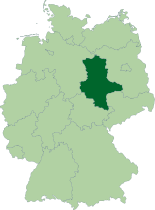Sachsen-Anhalt
|
Saxony-Anhalt Sachsen-Anhalt (German) |
|||
|---|---|---|---|
| State of Germany | |||
|
|||
 |
|||
| Coordinates: 51°58′16″N 11°28′12″E / 51.97111°N 11.47000°E | |||
| Country | Germany | ||
| Capital | Magdeburg | ||
| Government | |||
| • Minister-President | Reiner Haseloff (CDU) | ||
| • Governing parties | CDU / SPD / Greens | ||
| • Bundesrat votes | 4 (of 69) | ||
| Area | |||
| • Total | 20,451.58 km2 (7,896.40 sq mi) | ||
| Population (2015-12-31) | |||
| • Total | 2,245,470 | ||
| • Density | 110/km2 (280/sq mi) | ||
| Time zone | CET (UTC+1) | ||
| • Summer (DST) | CEST (UTC+2) | ||
| ISO 3166 code | DE-ST | ||
| GDP/ Nominal | €56 billion (2014) | ||
| GDP per capita | €24,000 (2014) | ||
| NUTS Region | DEE | ||
| Website | sachsen-anhalt.de | ||
Saxony-Anhalt (German: Sachsen-Anhalt, pronounced [ˌzaksn̩ ˈʔanhalt]) is a landlocked federal state of Germany surrounded by the federal states of Lower Saxony, Brandenburg, Saxony and Thuringia.
Its capital is Magdeburg and its largest city is Halle (Saale). Saxony-Anhalt covers an area of 20,447.7 square kilometres (7,894.9 sq mi) and has a population of 2.34 million. It is the 8th largest state in Germany by area and the 10th largest by population.
The state of Saxony-Anhalt grew out of the former Prussian Province of Saxony and Free State of Anhalt during Prussia's dissolution after World War II. In 1945 the US army administration and, subsequently, the Soviet army administration organised the former province's territory into the new state. The state became a part of the newly established German Democratic Republic in 1947 but in 1952 the state was dissolved and its territory was divided into the East German districts of Halle and Magdeburg, with the exception of the city of Torgau which joined Leipzig. After German reunification in 1990, the state was re-established, leaving out Torgau.
...
Wikipedia


